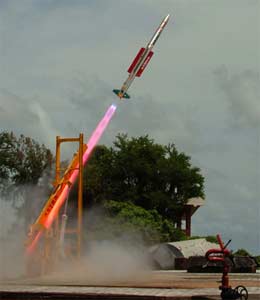'Astra' undergoes second successful test firing
16 Sep 2008
Balasore: 'Astra', the indigenously developed beyond visual range (BVR) air-to-air missile was successfully test fired from the integrated test range (ITR) at Chandipur in Orissa for the second consecutive day on Sunday.
 The anti-aircraft missile, capable of ducking radar eyes and attacking enemy targets up to 110 km, was test fired from launch pad number 2 of the ITR complex at about 11.47 am, defence sources said.
The anti-aircraft missile, capable of ducking radar eyes and attacking enemy targets up to 110 km, was test fired from launch pad number 2 of the ITR complex at about 11.47 am, defence sources said.
The test was conducted after an analysis of the data generated from yesterday's flight trial in order to further validate all major parameters, they said.
'Astra' is a futuristic missile and will intercept the target at super-sonic speeds of Mach 1.2 to 1.4, Defence Research Development Organisation scientists said.
The sleek single stage, solid fuel-fueled 'Astra' is more advanced in its category than the contemporary BVR missiles and is capable of engaging and destroying highly manoeuvrable supersonic aerial targets, a DRDO source said.
Some more trials would be conducted before the highly sophisticated missile system before is made fully operational, though test on its navigation, control, air frame, propulsion and other sub-systems have been validated, the source said.
Though the exact range of the trials conducted yesterday and today had not been disclosed, scientists are working to ensure that 'Astra' performed effectively at different altitudes - one cruising at an altitude of 15 km with 90 to 110 km range, another at an altitude up to 30,000 ft, having a range of 44 km and the third at sea level altitude with a range of 30 km, the sources said.
'Astra' is proposed to be integrated with combat fighter aircraft Sukhoi-30 next year and had undergone two experimental flight tests from the ITR launch complex at Chandipur on March 25 and 26 last year to study the ballistic performance and control of the missile at a low altitude and shorter range.
The tactical missile is capable of engaging and destroying fast moving aircraft at supersonic speed. It is 3.6 meters long, 7 inches in diameter and has launch weight of about 154 kg amking it the smallest weapon of DRDO's guided missile development programme in terms of size and weight.
It is capable of carrying 15 kg war head, the sources said.
Initially planned to arm Jaguar, Mig-29 and the indigenous light combat air-craft 'Tejas', DRDO officials are now concentrating on integrating the missile with Indian Air Force's front line fighter air-craft like Sukhoi-30 MKIs and Mirrage-2000.
The 'Astra' missile project is guided and led by Hyderabad-based Defence Research and Development Laboratory (DRDL) under the DRDO.
The prototype of the missile was first tested between May 9 and May 12, 2003 from the integrated test range at Chandipur.













.jpg)






.jpg)









